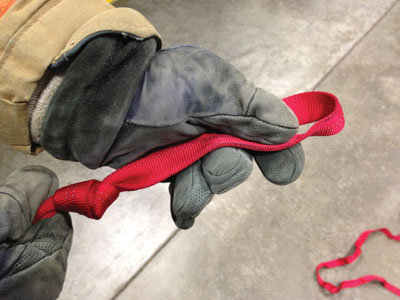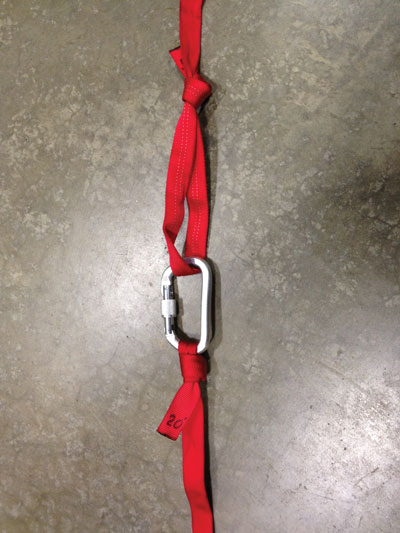
Tim-Bits: January 2013
Tim Llewellyn
Features Structural TrainingNo firefighter can ever know everything or do it all. Sharing safe ideas and methods makes our jobs easier and allows us to gain valuable knowledge.
No firefighter can ever know everything or do it all. Sharing safe ideas and methods makes our jobs easier and allows us to gain valuable knowledge.
 |
|
| The overhand loop of the Kovac Strap should be large enough to fit a gloved hand inside. The loop should also be twisted so that the webbing does not lie flat against itself, making it easier to open during times of obscured vision. Photos by Tim Llewellyn
|
Outside of training, I have never rescued a fire victim from an upper-floor window via the bucket of a tower ladder, but I have learned how to do it from firefighters who have. Their experiences and the knowledge they have gained and shared with me will allow me to reproduce what they have taught and have accomplished.
As I travel to different parts of Canada and the United States for training or teaching assignments, I try to pick up one idea or tip that is new to me and that works, and then I make a point of incorporating that idea into my future training sessions. I’ve written in the past about different webbing techniques and webbing storage tips, but this idea – the Kovac Strap – is unique in its simplicity: it takes an ordinary piece of one-inch tubular or flat webbing and turns it into a versatile, multi-use piece of equipment that no firefighter should be without.

|
|
| A Kovac Strap takes an ordinary piece of webbing and turns it into a versatile, multi-use piece of equipment that no firefighter should be without.
|
This device is named for Fire Chief Brian Kovac, of the Cranberry Township Volunteer Fire Company in Pennsylvania, a wise instructor from whom I have had the opportunity to learn on many occasions. The Kovac Strap is a simple modification of a continuous loop of webbing. What separates the Kovak Strap from the simple, continuous loop is the addition of one piece of hardware – a carabiner – and a simple, non-traditional loop.
To construct the Kovac Strap, start with a 4.5-metre to six-metre (15-foot to 20-foot) piece of webbing and attach a carabiner to one end with a loop secured by a double overhand knot. Keep the loop tight against the carabiner, so that it stays in place with the tension created by the double overhand knot; this will facilitate opening and closing the carabiner and make it easy to find during low-visibility operations. On the opposite end of the webbing, tie an overhand loop. Make the loop 15 centimetres (five to six inches) deep, or big enough to fit a gloved hand inside. When you tie the overhand loop, twist the webbing half way so that the loop does not lay flat against itself. A twisted loop is better than a flat loop because it is easier to open with a gloved hand when your vision is obstructed or obscured. To open the loop, simply grasp the knot between your thumb and forefinger and run your thumb to the end of the loop. When your fingers get to the end, the twist will allow the loop to open, whereas a flat loop will not. Next, open the carabiner and place the loop through it. The Kovac Strap is now complete and ready for use.
The Kovac Strap can be used many ways:
Use it as a traditional continuous loop of webbing to drag an unconscious victim; make a girth hitch from it, placing the girth hitch around the victim’s chest or feet and use the loop on the free end as a hand hold.
Use it to help another firefighter drag a large victim. While one firefighter uses the traditional girth hitch method, un-loop the Kovac Strap at the carabiner and attach it to the other firefighter’s girth hitch, or create a girth hitch of your own around the victim. Transform the opposite end of your Kovac Strap into a girth hitch and place it across your shoulder and torso. The longer length of the Kovac Strap will enable you to help with the drag from in front of the other firefighter, allowing both firefighters to pull and maintain a narrow width for longer straight corridors.
- Unloop the Kovac Strap and lower the carabiner end out and down from second- or third-floor windows to haul equipment or tools.
- Use the Kovac Strap’s pre-tied ends to keep a rolled mattress securely together for easier removal.
- When searching large areas, the Kovac Strap can be used as a tag line for searching off of, or moving further away from, a search rope. Two different search arc widths can be used; one with the Kovac Strap in a continuous loop and the other with it un-looped.
The continuous loop of webbing is already a versatile piece of personal equipment that can be simply modified and used many ways. Try it; if you like it, pass it on.
Tim Llewellyn is a career firefighter for the Allegheny County Airport Authority in Pittsburgh, Penn. A volunteer firefighter since 1989, he currently serves for the Adams Area Fire District in Pennsylvania. He has recently been appointed as a suppression-level instructor for the Pennsylvania State Fire Academy. He has taught structural firefighting tactics extensively in Canada and the United States. E-mail him at llewllyn.fire@gmail.com
Print this page